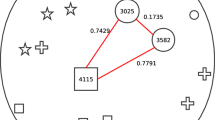Abstract
The Cold Start Recommender System (RS) for App usage prediction on mobile phones is important for improving new user experience on mobile operating systems. At present, the existing Cold Start RS computes the probability of App launching mainly by mining the potential information of new users and similar users (i.e., collaborative filtering algorithm CF). But for newly installed Apps, the default CF does not have any useful information for App Cold Start recommendation, resulting in the data sparseness. To tackle the problems, we think that App usage periodicity installed by the new user is regularly followed under different conditions. It not only compensates for the data sparseness of similar users but also increases the predictive flexibility when the user’s environment changes. Therefore, we designed Predictor, an efficient dynamic CF fusion algorithm that provides App Cold Start prediction for new users on mobile devices. It dynamically combines both App preferences of similar users (user-based CF) and App usage periodicity (item-based CF) through the conditional combination. Compared to other traditional methods, Predictor proposes more appropriate App launching recommendation and matches the launching expectations of most users.












Similar content being viewed by others
References
Xiang Z, Deng S, Liu S, Cao B, Yin J (2016) Camer: a context-aware mobile service recommendation system. In: 2016 IEEE international conference on web services (ICWS), pp 292–299
Baeza-Yates R, Jiang D, Silvestri F, Harrison B (2015) Predicting the next app that you are going to use. In: Proceedings of the eighth ACM international conference on web search and data mining, pp 285–294
Moshfeghi Y, Piwowarski B, Jose JM (2011) Handling data sparsity in collaborative filtering using emotion and semantic based features. In: Proceedings of the 34th international ACM SIGIR conference on research and development in information retrieval, pp 625–634
Liu NN, Meng X, Liu C, Yang Q (2011) Wisdom of the better few: cold start recommendation via representative based rating elicitation. In: Proceedings of the fifth ACM conference on recommender systems, pp 37–44
Zhou K, Yang SH, Zha H (2011) Functional matrix factorizations for cold-start recommendation. In: Proceedings of the 34th international ACM SIGIR conference on research and development in information retrieval, pp 315–324
Said A, De Luca EW, Albayrak S (2010) How social relationships affect user similarities. In: Proc. of the 2010 workshop on social recommender systems, pp 1–4
Lin J, Sugiyama K, Kan MY, Chua T-S (2013) Addressing cold-start in app recommendation: latent user models constructed from twitter followers. In: Proceedings of the 36th international ACM SIGIR conference on research and development in information retrieval, pp 283–292
Covington P, Adams J, Sargin E (2016) Deep neural networks for youtube recommendations. In: Proceedings of the 10th ACM conference on recommender systems, pp 191–198
Page L, Brin S, Motwani R, Winograd T (1999) The pagerank citation ranking: bringing order to the web., tech. rep., Stanford InfoLab
Koren Y, Bell R (2015) Advances in collaborative filtering. In: Recommender systems handbook. Springer, Berlin, pp 77–118
Adomavicius G, Tuzhilin A (2005) Toward the next generation of recommender systems: a survey of the state-of-the-art and possible extensions. IEEE Trans Knowl Data Eng 17(6):734–749
Su X, Khoshgoftaar TM (2009) A survey of collaborative filtering techniques. Adv Artif Intell 2009:4
Koren Y (2010) Factor in the neighbors: scalable and accurate collaborative filtering. ACM Trans Knowl Discov Data (TKDD) 4(1):1
Rendle S, Freudenthaler C, Schmidt-Thieme L (2010) Factorizing personalized markov chains for next-basket recommendation. In: Proceedings of the 19th international conference on World wide web, pp 811–820
Rashid AM, Albert I, Cosley D, Lam SK, McNee SM, Konstan JA, Riedl J (2002) Getting to know you: learning new user preferences in recommender systems. In: Proceedings of the 7th international conference on Intelligent user interfaces, pp 127–134
Bobadilla J, Ortega F, Hernando A, Bernal J (2012) A collaborative filtering approach to mitigate the new user cold start problem. Knowl Based Syst 26:225–238
Zhang M, Tang J, Zhang X, Xue X (2014) Addressing cold start in recommender systems: a semi-supervised co-training algorithm. In: Proceedings of the 37th international ACM SIGIR conference on Research and development in information retrieval, pp 73–82
Lu J, Wu D, Mao M, Wang W, Zhang G (2015) Recommender system application developments: a survey. Decis Support Syst 74:12–32
Liu R, Cao J, Zhang K, Gao W, Yang L, Liang J, Yu R (2016) Understanding mobile users’ privacy expectations: a recommendation-based method through crowdsourcing. IEEE Trans Serv Comput
Hu R, Zhu X, Cheng D, He W, Yan Y, Song J, Zhang S (2017) Graph self-representation method for unsupervised feature selection. Neurocomputing 220:130–137
Goralwalla IA, Leontiev Y, Özsu MT, Szafron D, Combi C (2001) Temporal granularity: completing the puzzle. J Intell Inf Syst 16(1):41–63
Bujari A, Licar B, Palazzi CE (2012) Movement pattern recognition through smartphone’s accelerometer. In: Consumer communications and networking conference (CCNC), 2012 IEEE, pp 502–506
Ester M, Kriegel H-P, Sander J, Xu X (1996) A density-based algorithm for discovering clusters in large spatial databases with noise. Kdd 96:226–231
Zhou C, Frankowski D, Ludford P, Shekhar S, Terveen L (2007) Discovering personally meaningful places: an interactive clustering approach. ACM Trans Inf Syst (TOIS) 25(3):12
Wang W-Z, R Wang, Xu C (2018) Discovering the relationship between generalization and uncertainty by incorporating complexity of classification. IEEE 48:703–715
Laurila JK, Gatica-Perez D, Aad I, Bornet O, Do T-M-T, Dousse O, Eberle J, Miettinen M, et al (2012) The mobile data challenge: Big data for mobile computing research. In: Pervasive computing, no. EPFL-CONF-192489
Fernández-Tobías I, Braunhofer M, Elahi M, Ricci F, Cantador I (2016) Alleviating the new user problem in collaborative filtering by exploiting personality information. User Model User Adapt Interact 26(2–3):221–255
Author information
Authors and Affiliations
Corresponding author
Additional information
Publisher's Note
Springer Nature remains neutral with regard to jurisdictional claims in published maps and institutional affiliations.
Rights and permissions
About this article
Cite this article
Han, D., Li, J., Yang, L. et al. A recommender system to address the Cold Start problem for App usage prediction. Int. J. Mach. Learn. & Cyber. 10, 2257–2268 (2019). https://doi.org/10.1007/s13042-018-0864-z
Received:
Accepted:
Published:
Issue Date:
DOI: https://doi.org/10.1007/s13042-018-0864-z




